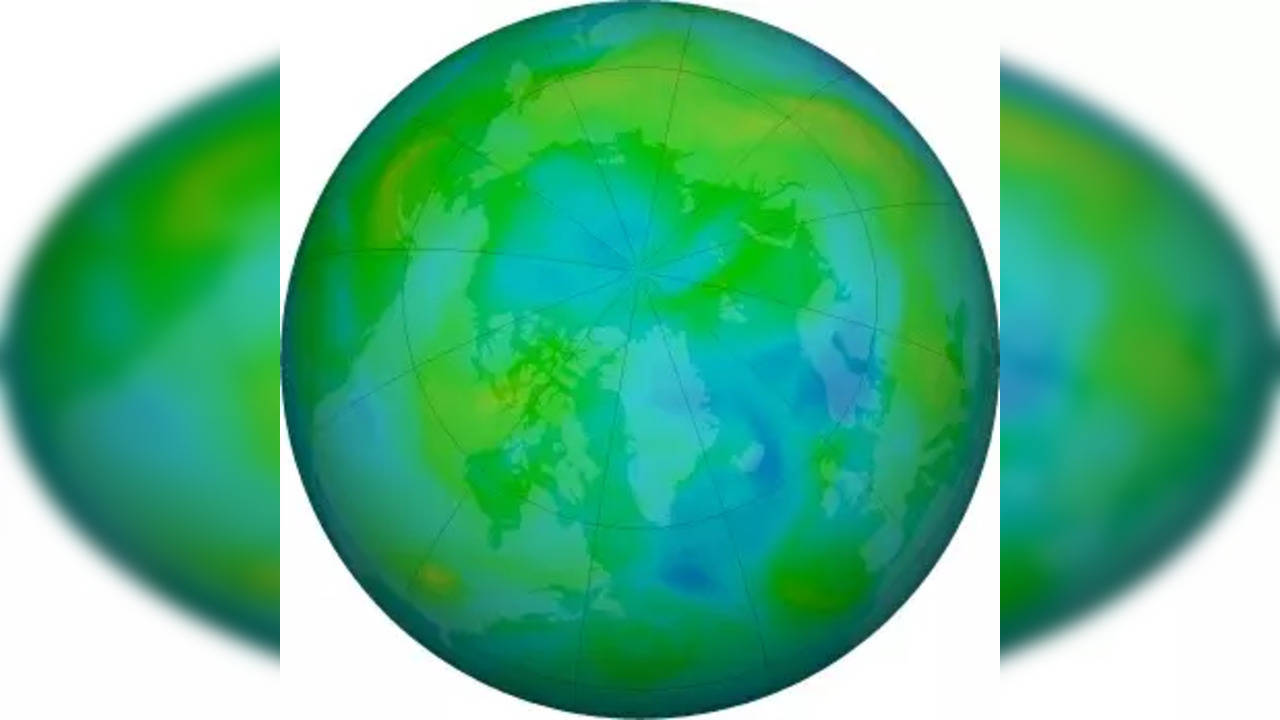International Ozone Day 2022: Hole in stratosphere shrinks due to worldwide curbs on CFCs; cancer-causing UV threat reduced
Scientists say that the alarm raised in the 1970s over the depletion of the Ozone layer over Earth has worked and the huge hole over Antarctica seems to be on the path to repair. How will that affect human health? Should we be relieved? The measures should continue so as to keep CFC emissions to the lowest, though.

September 12, 2022 - The latest false-colour view of total ozone over the Arctic pole. The purple and blue colours are where there is the least ozone, and the yellows and reds are where there is more ozone. (Image: NASA)
First up, the good news. The Ozone layer depletion seems to have stopped and is likely in a state of repair, say scientists in their latest findings.
The ozone layer, which is a protective shield over the earth, has been in a state of ill health - thinning out and developing gaping holes over the North and South poles that could have damaging effects on life on our planet. Located in the stratosphere (about 9 to 18 miles (15 to 30 kilometres) above the Earth's surface.), it is like a thin film that absorbs short-wave ultraviolet rays in sunlight.
Professor Mario Molina (1943–2020) - then a PhD student - was the first to realise that chlorofluorocarbons (CFCs) could destroy ozone. In the two decades following his discovery, he and his mentor - Professor Frank Sherwood "Sherry" Rowland (June 28, 1927 – March 10, 2012) kept alerting the world to the danger of CFCs and ozone depletion. Though initially ignored, their findings earned them a Nobel Prize.
CFCs are a class of compounds used as refrigerants, aerosol sprays, flame retardants, and solvents as well as in the making of plastic foams. CFCs, once they are released into the atmosphere - can be a major source of chlorine in the stratosphere. They also noted that chlorine could destroy extensive amounts of ozone after it was liberated from CFCs by UV radiation.
Professors Frank Sherwood Rowland and Mario Molina pointed out in the 1970s that a massive hole in the ozone layer in the North and South poles, almost the size of an area of up to 7.7 million square miles. They also predicted that the damage to the ozone layer will lead to excessive ultraviolet rays on the earth, which is a significant concern for human health.
Why is the Ozone layer important to human health?
According to NASA, the ozone layer absorbs 97-99 per cent of the sun's high-frequency ultraviolet light, the light which is potentially damaging to life on earth. Every 1 per cent decrease in the earth's ozone shield is projected to increase the amount of UV light exposure to the lower atmosphere by 2 per cent.
The ozone layer protects the Earth from the onslaught of the relentless ultraviolet radiation coming in from space - from our Sun. Without this protective layer that absorbs the radiation - the weather worldwide would change drastically, and crops and animals will also directly or indirectly affect growth and development. Human life would be disturbed in a horrific way.
Exposure to UVB radiation is linked with an increased risk of skin cancer and cataracts, as well as damage to plants and marine ecosystems. Basically, if we lose the Ozone layer, we can say goodbye to life as we know it as UVB radiation damages DNA in plants and animals (including humans) and leads to sunburns and skin cancer. There will be crop failures, mass extinctions, and rampant diseases among those who survive. For human and other life to be sustained on earth, the Ozone layer is of utmost importance.
The corrective action after the pledge of nations:
Following the worldwide shock over the manmade disaster of the Ozone layer depletion, in 1987, 46 countries signed the “Montreal Protocol on Substances that Deplete the Ozone Layer," making a pledge to protect the Ozone layer. which means that governments will protect the ozone. A complete ban on CFCs followed. Over the years, Montreal Protocol has taken a number of steps to protect the Ozone layer. Over the past 30 years, humans have made progress in stopping damage to the ozone layer by curbing the use of certain chemicals. But more remains to be done to protect and restore the atmospheric shield that sits in the stratosphere.
Where is the Ozone layer recovering?
According to scientists’ observations, the Antarctic ozone layer has seen the first signs of possible restoration. As CFCs in the upper atmosphere gradually decrease, it is predicted that the ozone hole will shrink to the size of 1980 by around 2070, reports suggest.
Disclaimer: Tips and suggestions mentioned in the article are for general information purposes only and should not be construed as professional medical advice. Always consult your doctor or a dietician before starting any fitness programme or making any changes to your diet.
Trending:
End of Article
Subscribe to our daily Lifestyle Newsletter!
Related News





Say Goodbye To Arm Fat: 5 Effective Exercises To Reduce Arm Fat

World Liver Day Special: 10 Juices That Will Help Your Liver Thrive

World Liver Day: Experts Debunk Myths About Coffee and Liver Health

Dentist Passes Away In Her Sleep Due To Headache; Can Migraines Kill You?

Are There Benefits or Risks Behind Eating Avocado Pits?








